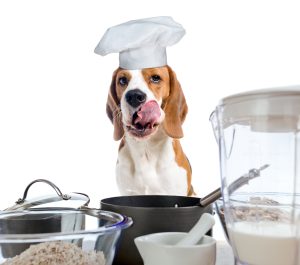
Cooking for Your Dog Can Be a Rewarding Experience.
Cooking for Your Dog: The Pros and Cons
Preparing homemade meals for your dog can seem like the ultimate act of love and care. As more pet owners consider this option, it’s essential to understand what cooking for your dog entails. Let’s delve into the pros and cons of homemade dog food to help you make an informed decision.
I get commissions for purchases made through links in this post. As an Amazon Associate I earn from qualifying purchases. You can read our disclaimer here.
Pros of Cooking for Your Dog
1. Control Over Ingredients:
- Benefit: You know exactly what’s going into your dog’s diet. This control is especially beneficial for dogs with allergies or sensitivities.
- Impact: It ensures your dog avoids fillers, additives, or preservatives often found in commercial dog food.
2. Tailored Nutrition:
- Benefit: Homemade meals can be tailored to your dog’s specific nutritional needs, age, weight, and health conditions. This is a great option for dogs with food sensitivities.
- Impact: This can lead to better weight management and overall health.
3. Freshness and Quality:
- Benefit: You can use fresh, high-quality ingredients, potentially leading to a more nutritious and palatable meal.
- Impact: Fresh meals can improve your dog’s coat, energy levels, and digestion.
4. Variety and Enjoyment:
- Benefit: Cooking allows you to offer a variety of meals, which can be more enjoyable for your dog.
- Impact:This variety can stimulate their appetite and make mealtimes more exciting.
Cons of Cooking for Your Dog
1. Time and Convenience:
- Con: Preparing homemade dog food can be time-consuming and less convenient than buying ready-made food. If you are set on cooking for your dog and want a more convenient way, the ChefPaw Dog Food Machine is the way to go.
- Impact:It may not be feasible for pet owners with a busy schedule.
2. Nutritional Balance:
- Con: Ensuring the right balance of nutrients can be challenging. Dogs require a specific ratio of protein, fats, carbohydrates, vitamins, and minerals. Nutra Thrive by Ultimate Pet Nutrition, is a great supplement whether you are cooking for your dog or not.
- Impact: An unbalanced diet can lead to nutritional deficiencies or excesses, harming your dog’s health.
3. Risk of Contamination:
- Con: Improper handling or cooking of ingredients can lead to bacterial contamination or foodborne illness.
- Impact: This can pose a health risk to both the pet and the owner.
4. Cost:
- Con: High-quality ingredients for homemade meals can be more expensive than commercial dog food.
- Impact: It may increase the overall cost of caring for your dog.
Best Practices for Cooking for Your Dog
1. Consult a Veterinarian:
Before switching to homemade meals, consult with a vet or a pet nutritionist to ensure the diet meets your dog’s nutritional needs.
2. Research Thoroughly:
Educate yourself on dog nutrition and safe cooking practices.
3. Start Slowly:
Gradually introduce homemade meals to avoid digestive upset.
4. Ensure Balance:
Use vet-approved recipes and consider supplements, such as Nutra Thrive, if recommended.
Conclusion
Cooking for your dog can be a rewarding experience, offering numerous health benefits. However, it’s crucial to consider the time, effort, and knowledge required to do it right. If you decide to cook for your dog, do so with proper guidance and awareness to ensure their dietary needs are met, and they continue to thrive.
